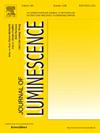Detection of electron spin resonance of a single nitrogen-vacancy center in diamond using the excited-state lifetime
IF 3.3
3区 物理与天体物理
Q2 OPTICS
引用次数: 0
Abstract
We demonstrated a high precision lifetime-based magnetometry with a single NV center in the bulk diamond. The magnetometry precision in long-time measurements under this scheme outperformed that in the conventional intensity-based method, showing precision robustness neglecting the accumulation of technical noises such as sample drifts or laser power fluctuations. A magnetic field sensitivity of 7.8 μT Hz−1/2 with a single NV center was achieved, which is 13 times improvement of previously demonstrated lifetime-based magnetometry with π-pulses. In addition, the lifetime-based electron spin detection method provides time-resolved spin dynamic information, can be further combined with recently reported continuous measurement protocols towards higher precision.
利用激发态寿命探测金刚石中单个氮空位中心的电子自旋共振
我们展示了在大块金刚石中使用单个 NV 中心的高精度基于寿命的磁力测量法。在该方案下进行的长时间测量中,磁力测量精度优于传统的基于强度的方法,在忽略样品漂移或激光功率波动等技术噪音积累的情况下,显示出精度的稳健性。单个 NV 中心的磁场灵敏度达到了 7.8 μT Hz-1/2,比之前使用 π 脉冲进行的基于寿命的磁力测量提高了 13 倍。此外,基于寿命的电子自旋检测方法提供了时间分辨的自旋动态信息,可以进一步与最近报道的连续测量协议相结合,实现更高的精度。
本文章由计算机程序翻译,如有差异,请以英文原文为准。
求助全文
约1分钟内获得全文
求助全文
来源期刊

Journal of Luminescence
物理-光学
CiteScore
6.70
自引率
13.90%
发文量
850
审稿时长
3.8 months
期刊介绍:
The purpose of the Journal of Luminescence is to provide a means of communication between scientists in different disciplines who share a common interest in the electronic excited states of molecular, ionic and covalent systems, whether crystalline, amorphous, or liquid.
We invite original papers and reviews on such subjects as: exciton and polariton dynamics, dynamics of localized excited states, energy and charge transport in ordered and disordered systems, radiative and non-radiative recombination, relaxation processes, vibronic interactions in electronic excited states, photochemistry in condensed systems, excited state resonance, double resonance, spin dynamics, selective excitation spectroscopy, hole burning, coherent processes in excited states, (e.g. coherent optical transients, photon echoes, transient gratings), multiphoton processes, optical bistability, photochromism, and new techniques for the study of excited states. This list is not intended to be exhaustive. Papers in the traditional areas of optical spectroscopy (absorption, MCD, luminescence, Raman scattering) are welcome. Papers on applications (phosphors, scintillators, electro- and cathodo-luminescence, radiography, bioimaging, solar energy, energy conversion, etc.) are also welcome if they present results of scientific, rather than only technological interest. However, papers containing purely theoretical results, not related to phenomena in the excited states, as well as papers using luminescence spectroscopy to perform routine analytical chemistry or biochemistry procedures, are outside the scope of the journal. Some exceptions will be possible at the discretion of the editors.
 求助内容:
求助内容: 应助结果提醒方式:
应助结果提醒方式:


